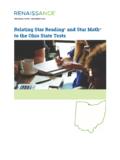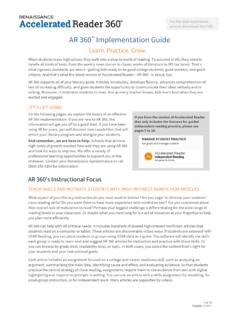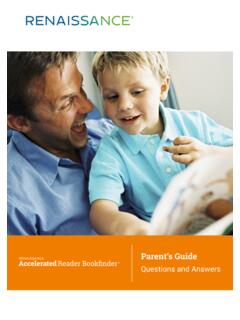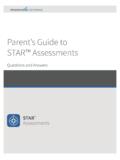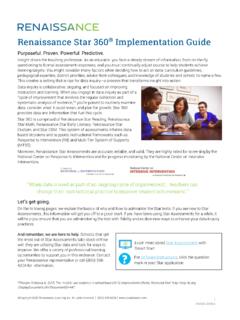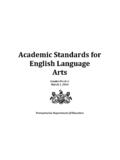Transcription of The Research Foundation for Accelerated Reader 360
1 WHITE PAPERThe Research Foundation for Accelerated Reader 360 2015 by Renaissance Learning, Inc. All rights reserved. Printed in the United States of America. All logos, designs, and brand names for Renaissance Learning s products and services, including but not limited to Accelerated Reader , Accelerated Reader 360, AR, AR 360, ATOS, Renaissance Learning, the Renaissance Learning logo, and STAR reading , are trademarks of Renaissance Learning, Inc., and its subsidiaries, registered, common law, or pending registration in the United States and other countries. All other product and company names should be considered the property of their respective companies and publication is protected by and international copyright laws.
2 It is unlawful to duplicate or reproduce any copyrighted material without authorization from the copyright holder. For more information, contact:RENAISSANCE Box 8036 Wisconsin Rapids, WI 54495-8036(800) Reader has strong evidence of effectiveness, the top rating for Prevention and Intervention at all grade levels, according to the National Dropout Prevention Reader is rated as a proven program that boosts reading achievement by the Promising Practice Reader meets criteria for scientifically based progress-monitoring tools set by the National Center on Student Progress Introduction2 About Accelerated Reader 360 4 Instructional reading practice 5 Independent reading practice 5 Getting the most out of reading practice: Factors of interest11 Goal setting14 ATOS.
3 Estimating text complexity and matching text to students17 Efficacy: Key Research support for Accelerated Reader 25 Conclusion26 Appendix. AR Goal-Setting Chart27 References Figures1 Figure 1. Performance on the ACT reading test by comprehension level (Averaged across seven forms) 2 Figure 2. Practice thickens myelin sheath6 Figure 3. Students with an APC between 85 95% on AR Quizzes experience the greatest reading gains7 Figure 4. Students reading as little as 15 24 minutes per day have notable achievement gains8 Figure 5. Characteristics of daily independent reading practice relate to growth and achievement outcomes9 Figure 6.
4 Suggested ZPD ranges by STAR reading GE score 10 Figure 7. Students reading with comprehension in and above their ZPD ranges make positive reading gains11 Figure 8. Students with goals set for independent reading practice read more and achieve better outcomes13 Figure 9. Dashboard example: reading -practice activity at a glance14 Figure 10. Dashboard example: Detailed diagnostics15 Figure 11. Mean ATOS level estimates reflect gap between secondary and postsecondary text complexity 15 Figure 12. Correlations between text complexity ratings and actual reference-text difficulty found all measures provided valid, reliable estimates17 Figure 13.
5 The better AR is implemented, the more students achieve growth and meet CCR benchmarks18 Figure 14. AR students far exceed control group gains19 Figure 15. Optimal reading practice begins within ZPD; successful comprehension leads to higher growth20 Figure 16. Struggling students reading scores rise with AR 20 Figure 17. Renaissance tools have significant impact on fifth-grade TLI scores21 Figure 18. reading achievement gains21 Figure 19. High AR implementers outperform low on CRCT22 Figure 20. AR users outgain controls23 Figure 21. AR improves school climate, reading and language scores24 Figure 22.
6 High AR users achieve more growth on GMRT24 Figure 23. AR students achieve higher gain scores on the American Guidance Service GRADE Test25 Figure 24. Teacher effectiveness increases on TVAAS as AR implementation improvesTables10 Table 1. Majority of books read are within students ZPD ranges; most quizzes are passed in or below 12 Table 2. AR Points on Goal-Setting Chart align with average points students earn per week16 Table 3. Recommended instructional ATOS ranges for Common Core State Standard grade bands18 Table 4. UK secondary students use Accelerated Reader in intervention with great results26 Table A1.
7 AR Goal-Setting Chartii1 IntroductionPractice is generally recognized as an essential component of any learning process (Willingham, 2009), and emphasizing the role of practice and hard work (rather than fixed intelligence) in academic accomplishments is beneficial for both motivation and performance (Mueller & Dweck, 1998). With regards to reading , practice builds vocabulary, fluency, comprehension, writing, and higher-order thinking skills ( , Anderson, Wilson, & Fielding, 1988; Baker, Simmons, & Kameenui, 1998; Greenfield, 2009; Guthrie, Wigfield, Metsala, & Cox, 1999) while also contributing to general abilities such as visual-information processing and speech perception (Dehaene et al.)
8 , 2010; McBride-Chang et al., 2011). Research suggests time spent reading books in other words, reading practice is the best predictor of overall academic achievement, even more than socioeconomic status or ethnicity (Kirsch et al., 2002). Similarly, results from the National Assessment of Educational Progress (National Center for Education Statistics, 1999) indicate that at all three grades assessed [4, 8, and 12], students who reported reading more pages daily in school and for homework had higher average scale scores than students who reported reading fewer pages daily (p. v). reading practice and critical thinking are fundamentally linked to one another, with progress in one invariably leading to progress in the other.
9 ACT (2006) results indicate the two types of learning are very much connected, so that accurately assessing a student s literal reading comprehension may also provide an estimate of critical thinking ability. Literal reading comprehension helps students develop inferential thinking abilities (ACT, see figure 1; Willingham, 2009) and also aids critical thinking in building factual content-area 1. Performance on the ACT reading test by comprehension level (Averaged across seven forms)Note: Analysis was based on students who took any of seven test forms administered between fall 2003 and spring 2005.
10 It was not possible to analyze performance below a score of 11 due to the small number of students scoring in this with permission from ACT, Inc. (2006). reading between the lines: What the ACT reveals about college readiness in reading . Iowa City, knowledge provides background information that can increase understanding, but also provides structure that can aid in organizing, understanding, and recalling new information. One example of prior factual knowledge affecting the structure of new information is chunking, which involves combining multiple pieces of information into one single piece ( , seven letters HSUDNFJ versus one word ACHIEVE ).

